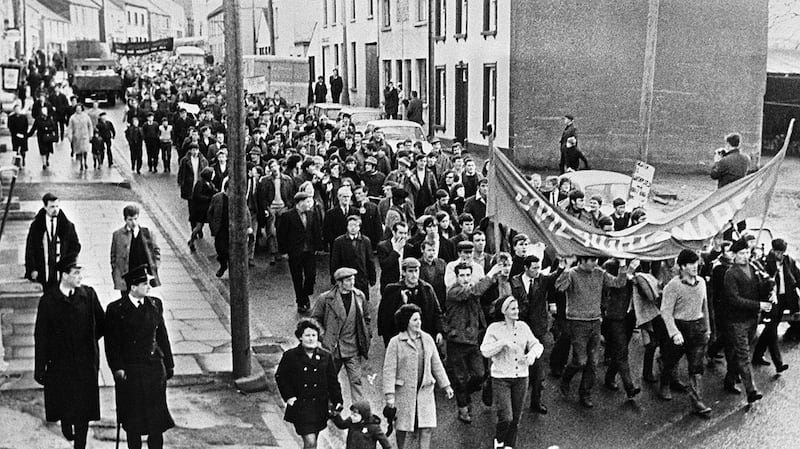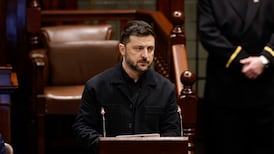The argument about whether the Provisional IRA’s actions during The Troubles were either inevitable, or necessary is one that has been debated much over the decades. It will be debated even more in the future.
Given my own involvement in the 1960s Northern Ireland civil rights movement before the Provisional IRA’s “armed struggle” began, I was interested to read The Irish Times’ interviews recently with former IRA members to mark the 30th anniversary of the 1994 ceasefire.
In those interviews, they claimed that they “were right to do it”.
The contrary argument, made in The Irish Times’ article, is that the civil rights campaign, the SDLP’s peaceful politics, together with demographic change, would have left Northern nationalists roughly where they are now, minus 30 years of conflict and 3,700 deaths.
Border was confirmed a century ago but the blame game is still a live issue
Why are British social media influencers in dark snugs seeking perfect pints of Guinness?
Manufacturing in Northern Ireland definitely not a thing of the past
‘Huge demand’ for Irish language classes as adult learners return to school decades on
In my opinion, Northern nationalists, and indeed unionists, would not be just where they are today if the peaceful civil rights approach had been followed from 1969 onward, but they would be, in fact, in a far more politically advanced position than they are at present.

Contemporary Sinn Féin is attempting to invent a respectable “myth of origin” for itself, one where the Provisional IRA campaign was in some way the continuation of the 1960s Northern civil rights movement.
In this construction of history, civil rights campaigners were “beaten off the streets” by the Paisleyites, the ultra-loyalists and the British”, prompting the Provisionals to come into being to “defend the people” and advance the civil rights aims.
The most cursory examination of history shows that this contention has no basis whatever. Unfortunately, most people either do not know, or if they are old enough have forgotten the facts of those years.
One reason for this ignorance is that, unfortunately, there is no book on the Northern civil rights movement which preceded the Provisional IRA campaign that does justice to its diverse elements, including the important solidarity movement in Britain at the time.
Many will disagree, I know, but the books that have been written, including by Bob Purdie, Dr Conn McCluskey, Eamon McCann, Bernadette Devlin, Simon Prince, have not, in my opinion, given a full picture of the times.
The facts are that prime minister Harold Wilson’s Labour government insisted on one-man-one vote and other civil rights reforms following the civil rights marches of August, October and November 1968, putting pressure on Terence O’Neill to act.
Following the splitting of the IRA into the “Officials” and the “Provisionals”, the latter not formed until over one year later – in December 1969 in the case of the IRA, and in January 1970 in the case of Provisional Sinn Féin.
Moreover, the Provisionals under the leadership of Sean Mac Stiofáin, Ruairi Ó Bradaigh and Co, were committed to violence from the very start, and the British government’s policy played right into their hands.
In 1968, Gerry Adams was a mere 21-year-old bartender in the York Bar, Belfast, and it took nearly 20 years before he and his colleagues came to lead the Provisionals and embarked on the “peace process”.
One of the reasons why the history of the Northern civil rights movement is not what it should be in, in my opinion, is that it relies excessively on the analysis of Eamon McCann, Bernadette Devlin and a number of others.
Both McCann and Devlin were significantly involved in the People’s Democracy movement which organised the Burntollet march of January 1969, which is generally agreed as having raised the sectarian temperature in the North.
That, in turn, contributed to the anti-Catholic explosion of August 1969, leading participants with an interest in justifying it, since the Burntollet march was held in defiance of the Northern Ireland Civil Rights Association.

In late 1968, it had sought a moratorium on provocative marches to give Terence O’Neill’s “reform programme” a chance, or to enable the Northern Ireland public to assess what those changes amounted to.
May I suggest that one way of answering whether the Provisional IRA’s actions were justified, and who was primarily responsible for what happened subsequently is to look at the history of the Troubles in the following way.
In 1969, British public opinion, and indeed global opinion, was overwhelmingly on the side of the Northern nationalists and the civil rights movement, with universal recognition that Northern Catholic had been getting a raw deal.
Ian Paisley and other unionist ultras were condemned. Just two years later, however, that situation was virtually completely reversed. The Northern problem was now seen primarily as one of containing IRA “terrorism”.
What brought about such a change in public opinion in Britain, but elsewhere internationally, too, so quickly? Clearly one factor was the republican split in January 1970, the formation of the Provisional IRA and the violence it inflicted.
The other significant factor, of course, was the replacement of Harold Wilson’s Labour government by Edward Heath’s Conservatives, which adopted a hard-line pro-unionist policy from the moment it took up office.
That led to the Falls Road curfew of July 1970, the Ballymurphy massacre of August 1971, Brian Faulkner’s introduction of internment without trial that same month and Bloody Sunday in Derry in January 1972.
Those four crucial incidents gave mass momentum to the newly formed Provisionals. Provisional IRA policy and British government policy thus mirrored one another from early 1970 onward, one feeding off the other.
Equally, a study of the Northern civil rights movement needs to do justice to the efforts made by Labour backbenchers in London, who put Wilson under pressure throughout the 1960s to force Stormont to make reforms.
In 1949, at the time of the Ireland Act, British Labour was overwhelmingly behind Ulster unionism. Twenty years later, it had changed. This, in my view, was due to the work of the Connolly Association and Desmond Greaves, editor of its monthly paper, the Irish Democrat.
The Connolly Association’s work is usually either ignored or downplayed by commentators who refer at all to the British side of things. This, in my mind, is because Greaves was a communist, even if a very independent-minded one.
In 1960/61, I was the full-time organiser for the Connolly Association in London. During that time, and earlier in the late 1940s, the Association lobbied the British Parliamentary Labour Party to protest about the internment of republican prisoners.
Consequently, over half of them sent telegrams over those decades to Northern Ireland’s prime minister Lord Brookeborough calling for the release of some 200 internees who had been imprisoned without charge or trial for years.
In 1961-62, the Association organised three marches across England calling for civil liberties reforms in Northern Ireland, so, historically, the first marches for Northern civil rights took place in Britain, not in the North.
This solidarity campaign went on all during the 1960s. In 1966, Stormont prime minister Terence O’Neill had an exchange of letters with the Association, showing how aware and concerned his government was about its campaign.
Material relating to all of this is now available on the Desmond Greaves Archive website at desmondgreavesarchive.com and in particular in Greaves’s 2 million-word Journal and his Table Talk on that site, which I have edited as his literary executor.
Former Trinity College lecturer Anthony Coughlan was a member of the Wolfe Tone Society during the 1960s, which campaigned for civil rights in Northern Ireland and supported the Northern Ireland Civil Rights Association












